driving MITSUBISHI ECLIPSE CROSS 2020 (in English) User Guide
[x] Cancel search | Manufacturer: MITSUBISHI, Model Year: 2020, Model line: ECLIPSE CROSS, Model: MITSUBISHI ECLIPSE CROSS 2020Pages: 427, PDF Size: 78.05 MB
Page 35 of 427
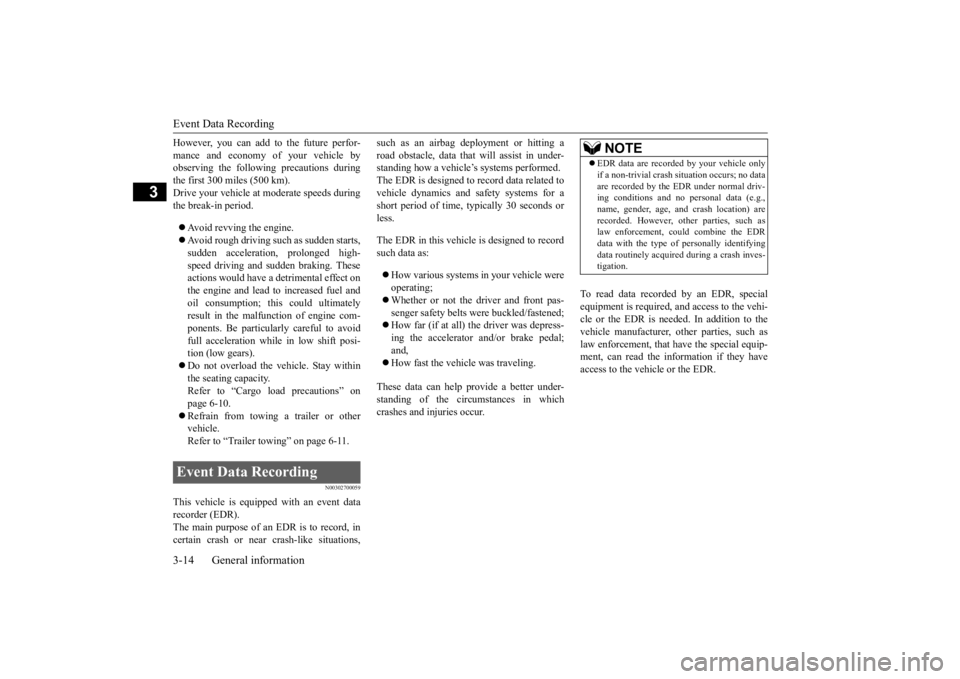
Event Data Recording 3-14 General information
3
However, you can add to the future perfor- mance and economy of your vehicle by observing the follow
ing precautions during
the first 300 miles (500 km).Drive your vehicle at moderate speeds during the break-in period. Avoid revving the engine. Avoid rough driving such as sudden starts, sudden acceleration, prolonged high- speed driving and sudden braking. These actions would have a detrimental effect onthe engine and lead to increased fuel andoil consumption; this could ultimately result in the malfunction of engine com- ponents. Be particularly careful to avoidfull acceleration while in low shift posi- tion (low gears). Do not overload the vehicle. Stay within the seating capacity. Refer to “Cargo load precautions” on page 6-10. Refrain from towing a trailer or other vehicle. Refer to “Trailer towing” on page 6-11.
N00302700059
This vehicle is equipped with an event datarecorder (EDR).The main purpose of an EDR is to record, in certain crash or near crash-like situations,
such as an airbag deployment or hitting a road obstacle, data that will assist in under- standing how a vehicle’s systems performed. The EDR is designed to record data related tovehicle dynamics and safety systems for a short period of time, typically 30 seconds or less. The EDR in this vehicle is designed to record such data as: How various systems in your vehicle were operating; Whether or not the driver and front pas- senger safety belts were buckled/fastened; How far (if at all) the driver was depress- ing the accelerator and/or brake pedal; and, How fast the vehicle was traveling.
These data can help provide a better under- standing of the circumstances in which crashes and injuries occur.
To read data recorded by an EDR, special equipment is required, and access to the vehi- cle or the EDR is needed. In addition to the vehicle manufacturer, other parties, such aslaw enforcement, that have the special equip- ment, can read the information if they have access to the vehicle or the EDR.
Event Data Recording
NOTE
EDR data are recorded by your vehicle only if a non-trivial crash situation occurs; no data are recorded by the EDR under normal driv- ing conditions and no personal data (e.g., name, gender, age, and crash location) arerecorded. However, other parties, such as law enforcement, could combine the EDR data with the type of personally identifyingdata routinely acquired during a crash inves- tigation.
BK0277700US.bo
ok 14 ページ 2019年3月8日 金曜日 午前9時23分
Page 38 of 427
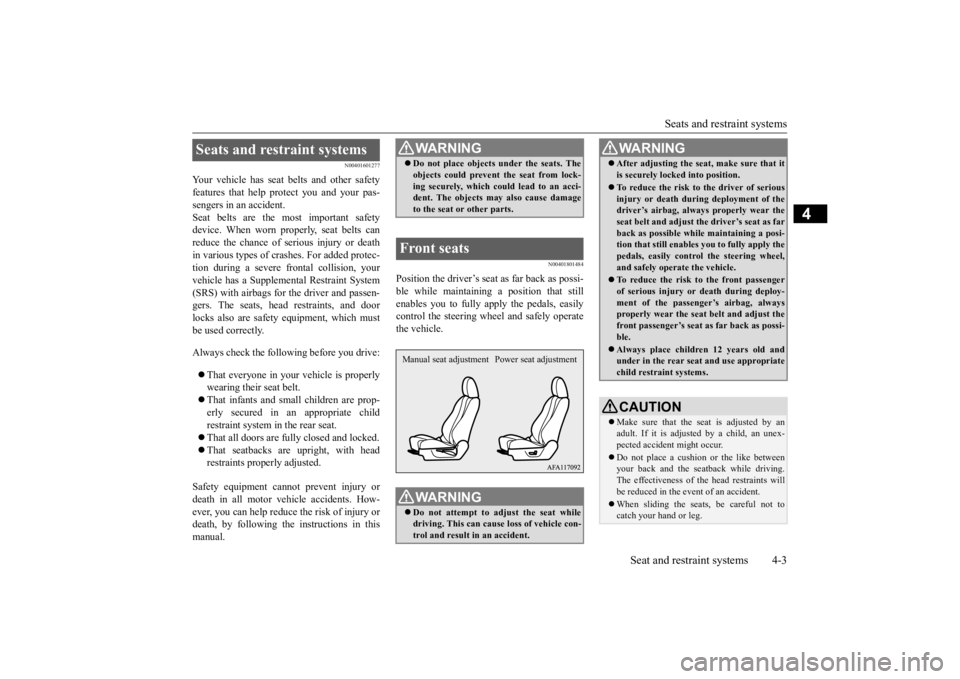
Seats and restraint systems
Seat and restraint systems 4-3
4
N00401601277
Your vehicle has seat belts and other safety features that help protect you and your pas-sengers in an accident. Seat belts are the most important safety device. When worn properly, seat belts canreduce the chance of serious injury or death in various types of crashes. For added protec- tion during a severe frontal collision, yourvehicle has a Supplemental Restraint System(SRS) with airbags for the driver and passen- gers. The seats, head restraints, and door locks also are safety equipment, which mustbe used correctly. Always check the following before you drive: That everyone in your vehicle is properly wearing their seat belt. That infants and small children are prop- erly secured in an appropriate child restraint system in the rear seat. That all doors are fully closed and locked. That seatbacks are upright, with head restraints properly adjusted.
Safety equipment cannot prevent injury or death in all motor vehicle accidents. How-ever, you can help reduce the risk of injury or death, by following the instructions in this manual.
N00401801484
Position the driver’s seat
as far back as possi-
ble while maintaining a position that still enables you to fully apply the pedals, easily control the steering wheel and safely operatethe vehicle.
Seats and restraint systems
WA R N I N G Do not place objects under the seats. The objects could prevent the seat from lock- ing securely, which could lead to an acci- dent. The objects ma
y also cause damage
to the seat or other parts.
Front seats
WA R N I N G Do not attempt to adjust the seat while driving. This can cause loss of vehicle con- trol and result in an accident.Manual seat adjustment Power seat adjustment
After adjusting the seat, make sure that it is securely locked into position. To reduce the risk to the driver of serious injury or death during deployment of thedriver’s airbag, always properly wear the seat belt and adjust th
e driver’s seat as far
back as possible while maintaining a posi-tion that still enables
you to fully apply the
pedals, easily control the steering wheel, and safely operate the vehicle. To reduce the risk to the front passenger of serious injury or death during deploy-ment of the passenger’s airbag, always properly wear the seat belt and adjust the front passenger’s seat as far back as possi-ble. Always place children 12 years old and under in the rear seat and use appropriate child restraint systems.CAUTION Make sure that the seat is adjusted by an adult. If it is adjusted by a child, an unex-pected accident might occur. Do not place a cushion or the like between your back and the seatback while driving. The effectiveness of the head restraints willbe reduced in the event of an accident. When sliding the seats, be careful not to catch your hand or leg.WA R N I N G
BK0277700US.bo
ok 3 ページ 2019年3月8日 金曜日 午前9時23分
Page 44 of 427

Head restraints
Seat and restraint systems 4-9
4
Each time the switch is pressed, the mode changes to the next one in the following sequence: OFF
HI
LO
OFF.
N00404301640
Head restraints can reduce the risk of a whip- lash injury if your vehicle is hit from the rear.The head restraints are equipped in the illus- trated position. To maximize the effectiveness of the headrestraints, adjust the seatback to the upright position, and the head
restraint to the proper
position. Sit back against the seatback withyour head close to the head restraint.
2 (OFF) - Heater off 3 (LO) - Heater low (to keep the seat-
warm)
For the rear outboard seats
OFF - Heater offHI - Heater high (for quick heating) LO - Heater low (to keep the seat warm)
NOTE
The rear seat switch will automatically return to “OFF” after the engine is stopped.
Head restraints
WA R N I N G Driving without the head restraints in place can cause you and your passengers serious injury or death in an accident. To reduce the risk of injury in an accident, always make sure the head restraints areinstalled and properly positioned when the seat is occupied. In order to minimize the risk of a neck injury due to a rear impact, the seatback must be adjusted to the upright positionand the head restraint must be adjusted to the proper position before vehicle opera- tion. The driver should never adjust theseat while the vehicle is in motion. Never place a cushion or similar device on the seatback. This can adversely affect head restraint performance by increasing the distance between your head and therestraint.
BK0277700US.bo
ok 9 ページ 2019年3月8日 金曜日 午前9時23分
Page 69 of 427
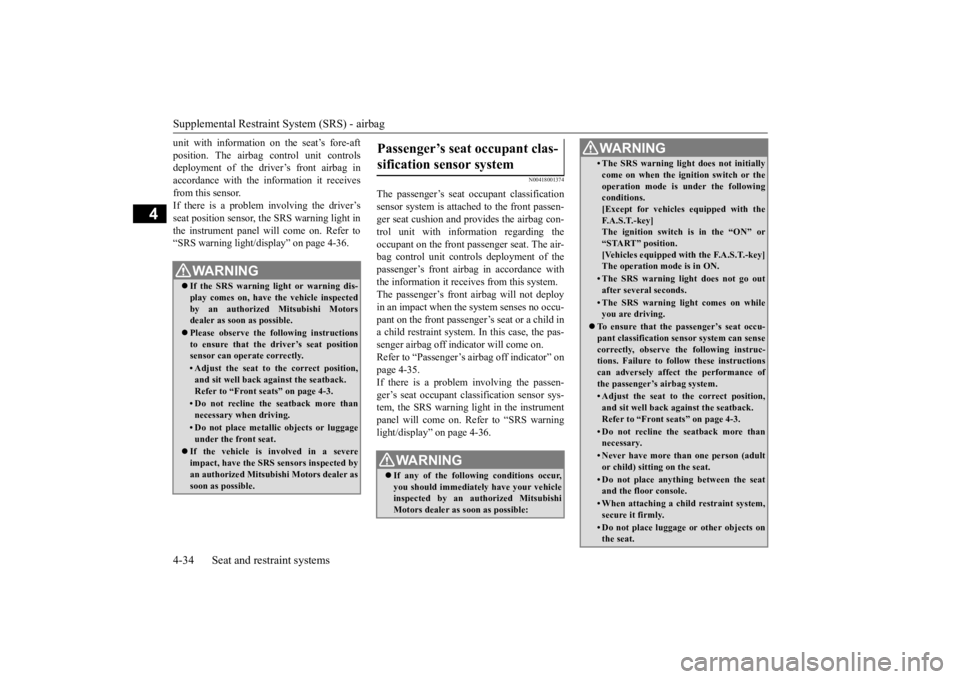
Supplemental Restraint System (SRS) - airbag 4-34 Seat and restraint systems
4
unit with information on the seat’s fore-aft position. The airbag control unit controls deployment of the driver’s front airbag in accordance with the information it receivesfrom this sensor. If there is a problem involving the driver’s seat position sensor, the SRS warning light inthe instrument panel will come on. Refer to “SRS warning light/display” on page 4-36.
N00418001374
The passenger’s seat occupant classification sensor system is attached to the front passen- ger seat cushion and provides the airbag con- trol unit with information regarding theoccupant on the front passenger seat. The air- bag control unit controls deployment of the passenger’s front airbag in accordance withthe information it receives from this system.The passenger’s front airbag will not deploy in an impact when the system senses no occu- pant on the front passenger’s seat or a child ina child restraint system. In this case, the pas- senger airbag off indicator will come on. Refer to “Passenger’s airbag off indicator” onpage 4-35. If there is a problem involving the passen- ger’s seat occupant classification sensor sys-tem, the SRS warning light in the instrument panel will come on. Refer to “SRS warning light/display” on page 4-36.
WA R N I N G If the SRS warning light or warning dis- play comes on, have the vehicle inspected by an authorized Mitsubishi Motors dealer as soon as possible. Please observe the following instructions to ensure that the driver’s seat positionsensor can operate correctly.• Adjust the seat to the correct position,and sit well back against the seatback. Refer to “Front seats” on page 4-3.• Do not recline the seatback more thannecessary when driving.• Do not place metallic objects or luggageunder the front seat.
If the vehicle is involved in a severe impact, have the SRS sensors inspected by an authorized Mitsubishi Motors dealer as soon as possible.
Passenger’s seat occupant clas- sification sensor system
WA R N I N G If any of the following conditions occur, you should immediately have your vehicleinspected by an authorized Mitsubishi Motors dealer as soon as possible:
• The SRS warning light does not initiallycome on when the ignition switch or the operation mode is under the following conditions. [Except for vehicles equipped with theF. A . S . T. - k e y ] The ignition switch is in the “ON” or “START” position.[Vehicles equipped with the F.A.S.T.-key] The operation mode is in ON.• The SRS warning light does not go outafter several seconds.• The SRS warning light comes on whileyou are driving.
To ensure that the passenger’s seat occu- pant classification sensor system can sense correctly, observe the following instruc-tions. Failure to follow these instructions can adversely affect the performance of the passenger’s airbag system.• Adjust the seat to the correct position,and sit well back against the seatback.Refer to “Front seats” on page 4-3.• Do not recline the seatback more thannecessary.• Never have more than one person (adultor child) sitting on the seat.• Do not place anything between the seat and the floor console.• When attaching a child restraint system,secure it firmly.• Do not place luggage or other objects onthe seat.WA R N I N G
BK0277700US.bo
ok 34 ページ 2019年3月8日 金曜日 午前9時23分
Page 71 of 427
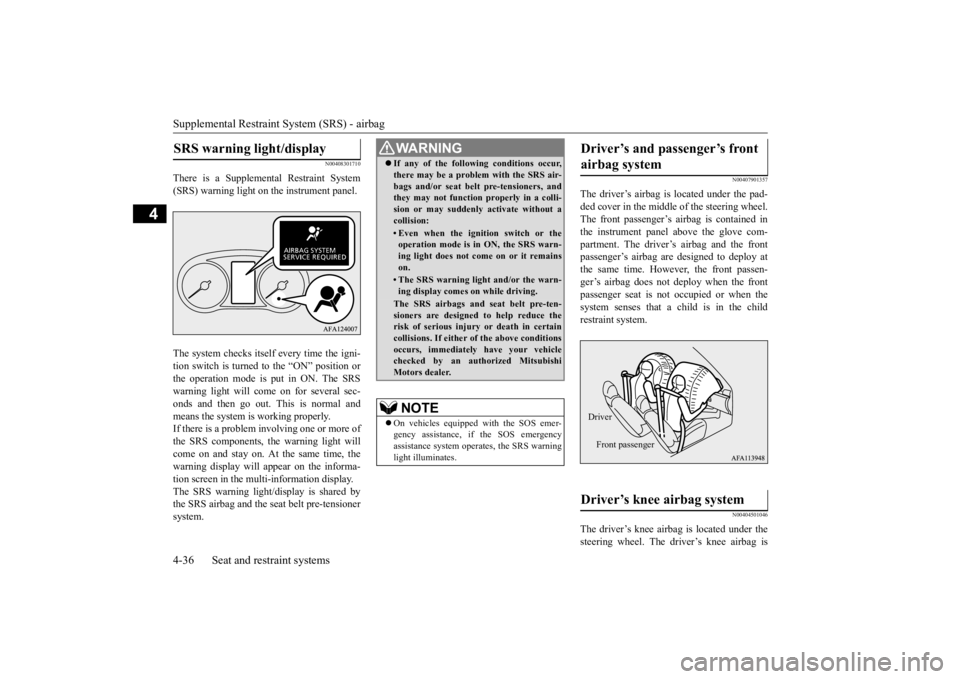
Supplemental Restraint System (SRS) - airbag 4-36 Seat and restraint systems
4
N00408301710
There is a Supplemental Restraint System (SRS) warning light on the instrument panel. The system checks itself every time the igni- tion switch is turned to the “ON” position orthe operation mode is put in ON. The SRSwarning light will come on for several sec- onds and then go out. This is normal and means the system is working properly.If there is a problem involving one or more of the SRS components, the warning light will come on and stay on. At the same time, thewarning display will appear on the informa- tion screen in the multi-information display. The SRS warning light/display is shared bythe SRS airbag and the seat belt pre-tensioner system.
N00407901357
The driver’s airbag is located under the pad- ded cover in the middle of the steering wheel. The front passenger’s airbag is contained in the instrument panel above the glove com-partment. The driver’s airbag and the front passenger’s airbag are designed to deploy at the same time. However,
the front passen-
ger’s airbag does not deploy when the frontpassenger seat is not occupied or when the system senses that a child is in the child restraint system.
N00404501046
The driver’s knee airbag
is located under the
steering wheel. The driver’s knee airbag is
SRS warning light/display
WA R N I N G If any of the following conditions occur, there may be a problem with the SRS air- bags and/or seat belt pre-tensioners, and they may not function properly in a colli- sion or may suddenly activate without acollision:• Even when the ignition switch or theoperation mode is in ON, the SRS warn- ing light does not come on or it remains on.• The SRS warning light and/or the warn-ing display comes on while driving.The SRS airbags and seat belt pre-ten-sioners are designed to help reduce therisk of serious injury or death in certain collisions. If either of the above conditions occurs, immediately have your vehiclechecked by an authorized Mitsubishi Motors dealer.NOTE
On vehicles equipped with the SOS emer- gency assistance, if the SOS emergency assistance system operates, the SRS warning light illuminates.
Driver’s and passenger’s front airbag system Driver’s knee airbag system Driver Front passenger
BK0277700US.bo
ok 36 ページ 2019年3月8日 金曜日 午前9時23分
Page 106 of 427
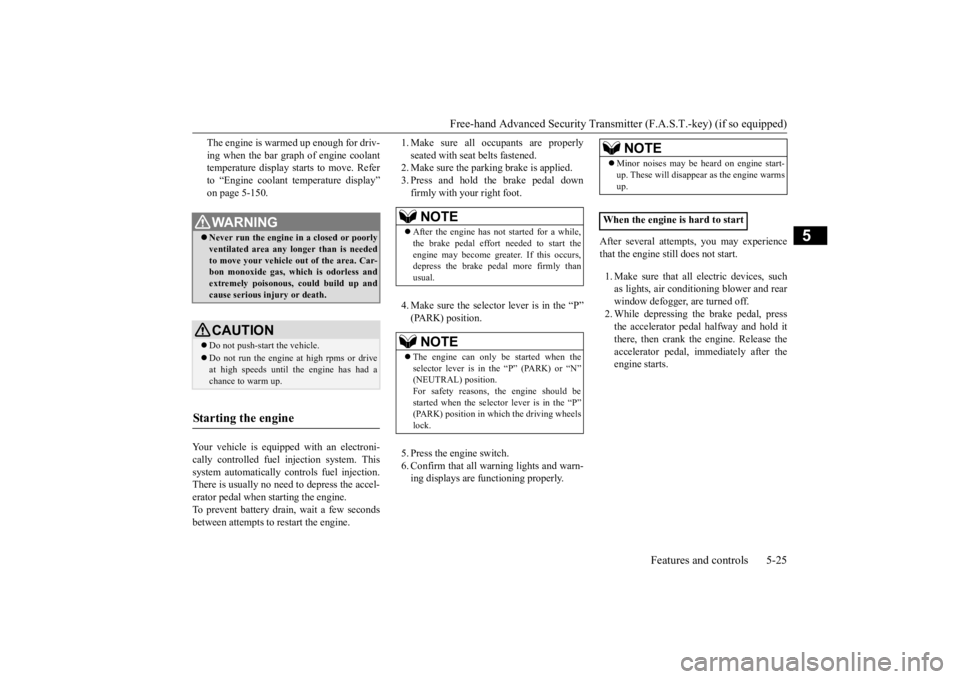
Free-hand Advanced Security Transmit
ter (F.A.S.T.-key) (if so equipped)
Features and controls 5-25
5
The engine is warmed up enough for driv- ing when the bar graph of engine coolant temperature display starts to move. Refer to “Engine coolant temperature display”on page 5-150.
Your vehicle is equipped with an electroni- cally controlled fuel injection system. This system automatically controls fuel injection.There is usually no need to depress the accel- erator pedal when starting the engine. To prevent battery drain, wait a few secondsbetween attempts to restart the engine.
1. Make sure all occupants are properly seated with seat belts fastened. 2. Make sure the parking brake is applied. 3. Press and hold the brake pedal downfirmly with your right foot. 4. Make sure the selector lever is in the “P” (PARK) position. 5. Press the engine switch. 6. Confirm that all warning lights and warn- ing displays are functioning properly.
After several attempts, you may experience that the engine still does not start. 1. Make sure that all electric devices, such as lights, air conditioning blower and rearwindow defogger, are turned off. 2. While depressing the brake pedal, press the accelerator pedal halfway and hold itthere, then crank the engine. Release the accelerator pedal, immediately after the engine starts.
WA R N I N G Never run the engine in a closed or poorly ventilated area any longer than is needed to move your vehicle out of the area. Car-bon monoxide gas, which is odorless and extremely poisonous, could build up and cause serious injury or death.CAUTION Do not push-start the vehicle.Do not run the engine at high rpms or drive at high speeds until the engine has had a chance to warm up.
Starting the engine
NOTE
After the engine has not started for a while, the brake pedal effort needed to start theengine may become greater. If this occurs, depress the brake pedal more firmly than usual.NOTE
The engine can only be started when the selector lever is in the “P” (PARK) or “N”(NEUTRAL) position. For safety reasons, the engine should be started when the selector lever is in the “P”(PARK) position in which the driving wheels lock.
NOTE
Minor noises may be heard on engine start- up. These will disappear as the engine warms up.
When the engine is hard to start
BK0277700US.bo
ok 25 ページ 2019年3月8日 金曜日 午前9時23分
Page 107 of 427
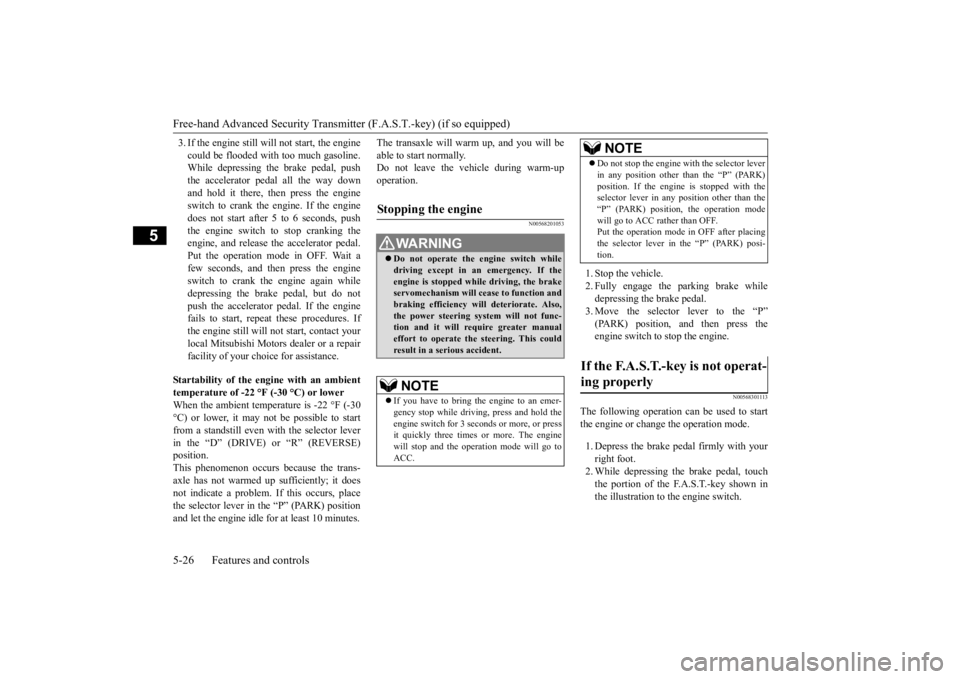
Free-hand Advanced Security Transmitter (F.A.S.T.-key) (if so equipped) 5-26 Features and controls
5
3. If the engine still will not start, the engine could be flooded with too much gasoline. While depressing the brake pedal, push the accelerator pedal all the way downand hold it there, then press the engine switch to crank the engine. If the engine does not start after 5 to 6 seconds, pushthe engine switch to stop cranking the engine, and release the accelerator pedal. Put the operation mode in OFF. Wait afew seconds, and then press the engineswitch to crank the engine again while depressing the brake pedal, but do not push the accelerator pedal. If the enginefails to start, repeat these procedures. If the engine still will not start, contact your local Mitsubishi Motors dealer or a repairfacility of your choice for assistance.
Startability of the engine with an ambient temperature of -22 °F (-30 °C) or lower When the ambient temperature is -22 °F (-30°C) or lower, it may not be possible to start from a standstill even with the selector lever in the “D” (DRIVE) or “R” (REVERSE)position. This phenomenon occurs because the trans- axle has not warmed up sufficiently; it doesnot indicate a problem. If this occurs, place the selector lever in the “P” (PARK) position and let the engine idle for at least 10 minutes.
The transaxle will warm up, and you will be able to start normally. Do not leave the vehicle during warm-up operation.
N00568201053
1. Stop the vehicle.2. Fully engage the parking brake while depressing the brake pedal. 3. Move the selector lever to the “P”(PARK) position, and then press the engine switch to stop the engine.
N00568301113
The following operation can be used to start the engine or change the operation mode. 1. Depress the brake pe
dal firmly with your
right foot. 2. While depressing the brake pedal, touch the portion of the F.A.S.T.-key shown inthe illustration to the engine switch.
Stopping the engine
WA R N I N G Do not operate the engine switch while driving except in an emergency. If the engine is stopped while driving, the brake servomechanism will cease to function andbraking efficiency will deteriorate. Also, the power steering system will not func- tion and it will require greater manualeffort to operate the steering. This could result in a serious accident.NOTE
If you have to bring the engine to an emer- gency stop while driving, press and hold the engine switch for 3 seco
nds or more, or press
it quickly three times or more. The enginewill stop and the operation mode will go to ACC.
Do not stop the engine with the selector lever in any position other than the “P” (PARK) position. If the engine is stopped with the selector lever in any position other than the “P” (PARK) position, the operation modewill go to ACC rather than OFF. Put the operation mode in OFF after placing the selector lever in the “P” (PARK) posi-tion.
If the F.A.S.T.-key is not operat- ing properly
NOTE
BK0277700US.bo
ok 26 ページ 2019年3月8日 金曜日 午前9時23分
Page 116 of 427
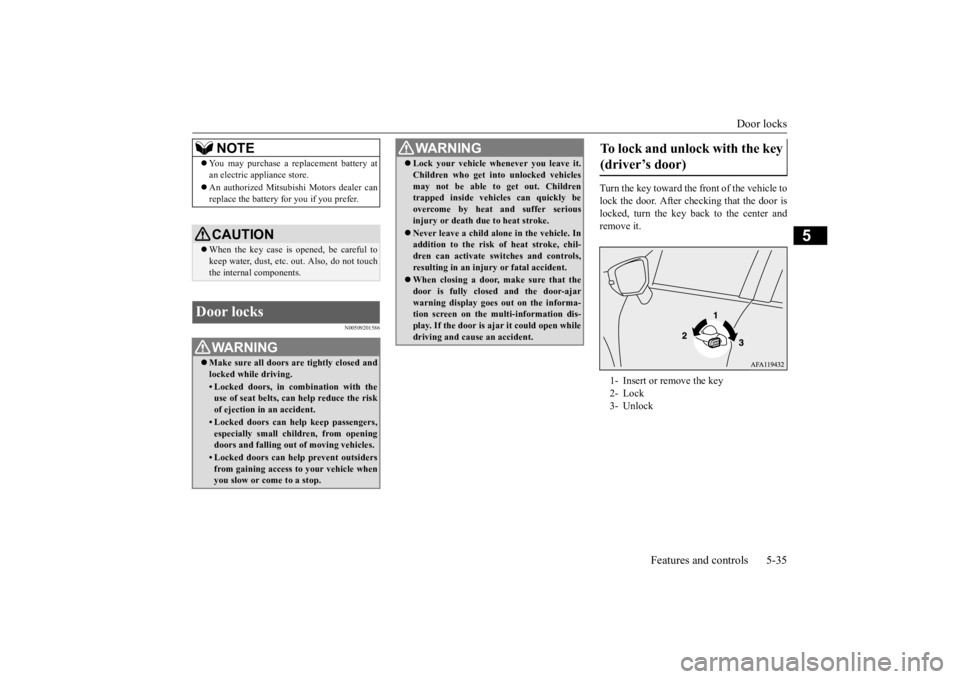
Door locks
Features and controls 5-35
5
N00509201586
Turn the key toward the front of the vehicle to lock the door. After ch
ecking that the door is
locked, turn the key back to the center and remove it.
NOTE
You may purchase a replacement battery at an electric appliance store. An authorized Mitsubishi Motors dealer can replace the battery for you if you prefer.CAUTION When the key case is opened, be careful to keep water, dust, etc.
out. Also, do not touch
the internal components.
Door locks
WA R N I N G Make sure all doors are tightly closed and locked while driving.• Locked doors, in combination with theuse of seat belts, can help reduce the risk of ejection in an accident.• Locked doors can help keep passengers,especially small children, from opening doors and falling out of moving vehicles.• Locked doors can help prevent outsidersfrom gaining access to your vehicle when you slow or come to a stop.
Lock your vehicle whenever you leave it. Children who get into unlocked vehicles may not be able to get out. Children trapped inside vehicles can quickly be overcome by heat and suffer seriousinjury or death due to heat stroke. Never leave a child alone in the vehicle. In addition to the risk of heat stroke, chil- dren can activate switches and controls, resulting in an injury or fatal accident. When closing a door, make sure that the door is fully closed and the door-ajarwarning display goes out on the informa- tion screen on the multi-information dis- play. If the door is ajar it could open whiledriving and cause an accident.WA R N I N G
To lock and unlock with the key (driver’s door) 1- Insert or remove the key 2- Lock 3- Unlock
BK0277700US.bo
ok 35 ページ 2019年3月8日 金曜日 午前9時23分
Page 120 of 427
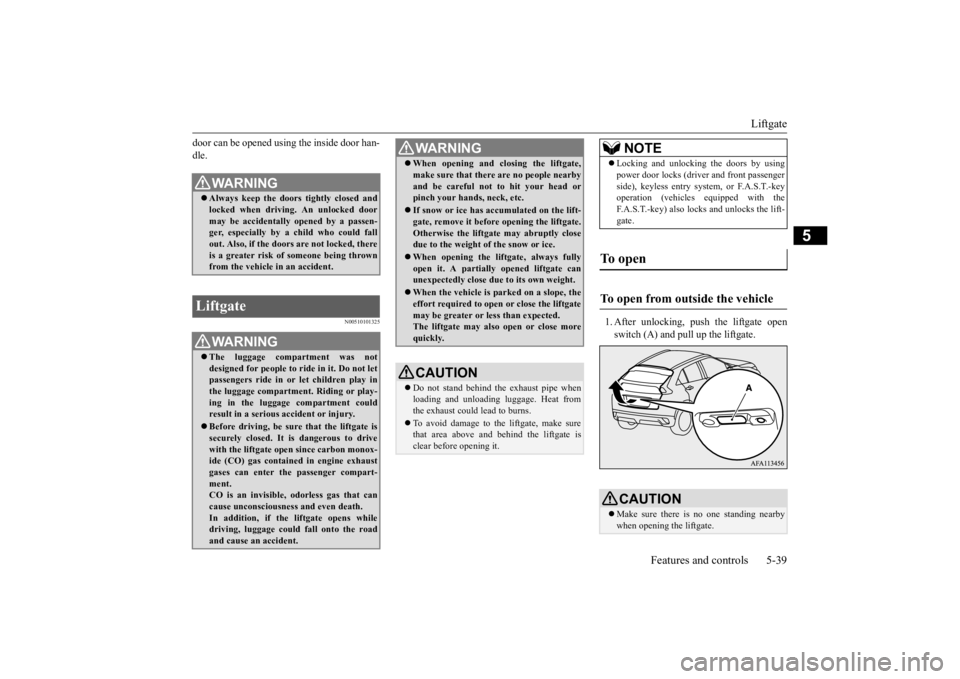
Liftgate
Features and controls 5-39
5
door can be opened using the inside door han- dle.
N00510101325
1. After unlocking, push the liftgate open switch (A) and pull up the liftgate.
WA R N I N G Always keep the doors tightly closed and locked when driving. An unlocked door may be accidentally opened by a passen-ger, especially by a child who could fall out. Also, if the doors are not locked, there is a greater risk of someone being thrownfrom the vehicle in an accident.
Liftgate
WA R N I N G The luggage compartment was not designed for people to ride in it. Do not letpassengers ride in or
let children play in
the luggage compartment. Riding or play- ing in the luggage compartment couldresult in a serious accident or injury. Before driving, be sure that the liftgate is securely closed. It is dangerous to drive with the liftgate open
since carbon monox-
ide (CO) gas contained in engine exhaust gases can enter the passenger compart- ment.CO is an invisible, odorless gas that can cause unconsciousness and even death. In addition, if the liftgate opens whiledriving, luggage could fall onto the road and cause an accident.
When opening and closing the liftgate, make sure that there are no people nearby and be careful not to hit your head or pinch your hands, neck, etc. If snow or ice has accumulated on the lift- gate, remove it before opening the liftgate. Otherwise the liftgate may abruptly closedue to the weight of the snow or ice. When opening the liftgate, always fully open it. A partially opened liftgate can unexpectedly close due to its own weight. When the vehicle is pa
rked on a slope, the
effort required to open or close the liftgate may be greater or less than expected.The liftgate may also open or close more quickly.CAUTION Do not stand behind the exhaust pipe when loading and unloading luggage. Heat fromthe exhaust could lead to burns. To avoid damage to the liftgate, make sure that area above and behind the liftgate is clear before opening it.WA R N I N G
NOTE
Locking and unlocking the doors by using power door locks (driver and front passenger side), keyless entry system, or F.A.S.T.-key operation (vehicles equipped with the F.A.S.T.-key) also locks and unlocks the lift-gate.
To open To open from outside the vehicle
CAUTION Make sure there is no one standing nearby when opening the liftgate.
BK0277700US.bo
ok 39 ページ 2019年3月8日 金曜日 午前9時23分
Page 121 of 427
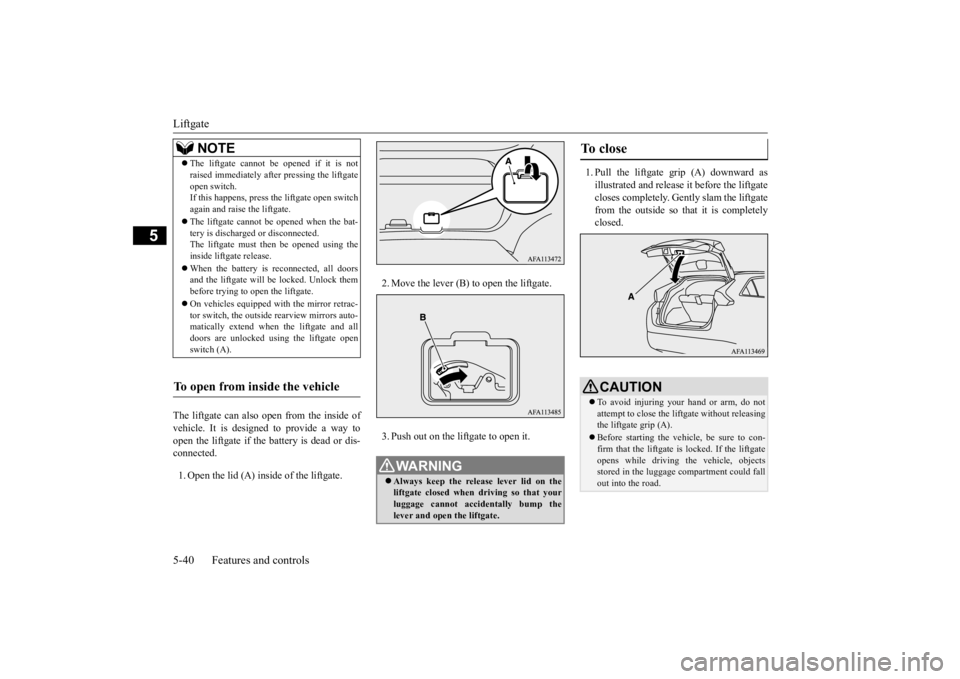
Liftgate 5-40 Features and controls
5
The liftgate can also open from the inside of vehicle. It is designed to provide a way to open the liftgate if the battery is dead or dis- connected. 1. Open the lid (A) inside of the liftgate.
2. Move the lever (B) to open the liftgate. 3. Push out on the liftgate to open it.
1. Pull the liftgate grip (A) downward as illustrated and release it before the liftgate closes completely. Gently slam the liftgatefrom the outside so
that it is completely
closed.
NOTE
The liftgate cannot be opened if it is not raised immediately after pressing the liftgate open switch. If this happens, press the liftgate open switch again and raise the liftgate. The liftgate cannot be opened when the bat- tery is discharged or disconnected.The liftgate must then be opened using the inside liftgate release. When the battery is reconnected, all doors and the liftgate will be locked. Unlock them before trying to open the liftgate. On vehicles equipped with the mirror retrac- tor switch, the outside rearview mirrors auto-matically extend when the liftgate and all doors are unlocked using the liftgate open switch (A).
To open from inside the vehicle
WA R N I N G Always keep the release lever lid on the liftgate closed when driving so that your luggage cannot accidentally bump the lever and open the liftgate.
To close
CAUTION To avoid injuring your hand or arm, do not attempt to close the liftgate without releasingthe liftgate grip (A). Before starting the vehicle, be sure to con- firm that the liftgate
is locked. If the liftgate
opens while driving the vehicle, objects stored in the luggage compartment could fallout into the road.
BK0277700US.bo
ok 40 ページ 2019年3月8日 金曜日 午前9時23分